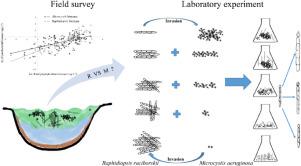Harmful Algae ( IF 5.5 ) Pub Date : 2020-06-24 , DOI: 10.1016/j.hal.2020.101858 Nannan Jia 1 , Yiming Yang 2 , Gongliang Yu 3 , Yilang Wang 1 , Pengfei Qiu 1 , Hua Li 3 , Renhui Li 4

|
As a successful invasive cyanobacterial species, Raphidiopsis raciborskii is distributed globally and shows a tendency to replace Microcystis aeruginosa in many subtropical and temperate waters, but the ecological traits that contribute to its invasiveness are still unclear. In this study, we found that R. raciborskii occurred in 149 sites in 42 lakes in eastern and central China and coexisted with M. aeruginosa at most sites. Based on field results, a combination of invasion and competition experiments using a biomass gradient to evaluate the invasiveness and competitiveness of R. raciborskii compared with M. aeruginosa was conducted. In invasive groups, both R. raciborskii and M. aeruginosa were shown to have positive specific growth rates, indicating that R. raciborskii could coexist with M. aeruginosa. Furthermore, R. raciborskii was shown to grow faster from invasion while M. aeruginosa reduced growth for invasion. In competitive groups, R. raciborskii reached a higher maximum biomass and grew longer than M. aeruginosa. The specific growth rate of R. raciborskii was not inhibited by M. aeruginosa biomass, whereas the growth of M. aeruginosa was inhibited by R. raciborskii biomass. It was shown during the whole experiment that R. raciborskii tended to replace M. aeruginosa to become dominant owing to its faster growth rate and the eventual decline in growth of M. aeruginosa. With an increase in biomass of M. aeruginosa, the vegetative cell size and filament length of R. raciborskii gradually increased. This study has demonstrated that the inherent invasive traits of R. raciborskii, size differences, niche differences, and relative fitness differences between R. raciborskii and M. aeruginosa are crucial reasons for the invasive success of R. raciborskii. Our results revealed the invasiveness and domination of R. raciborskii from a new perspective.











































 京公网安备 11010802027423号
京公网安备 11010802027423号